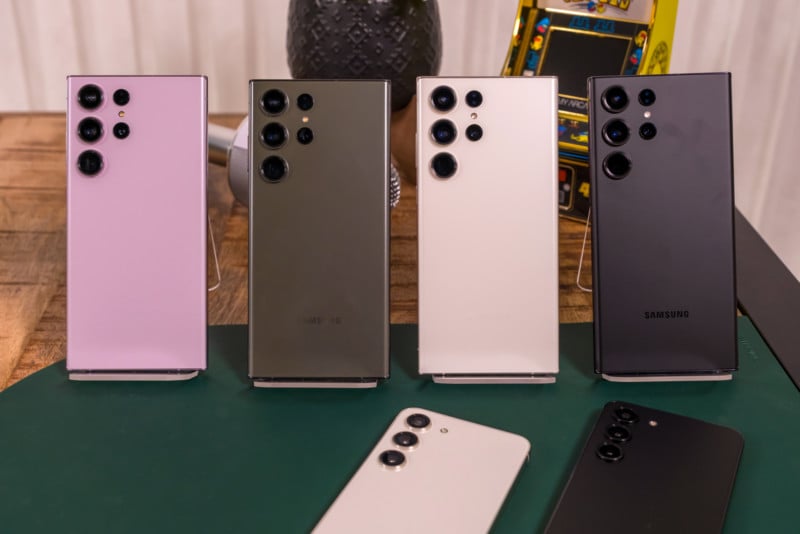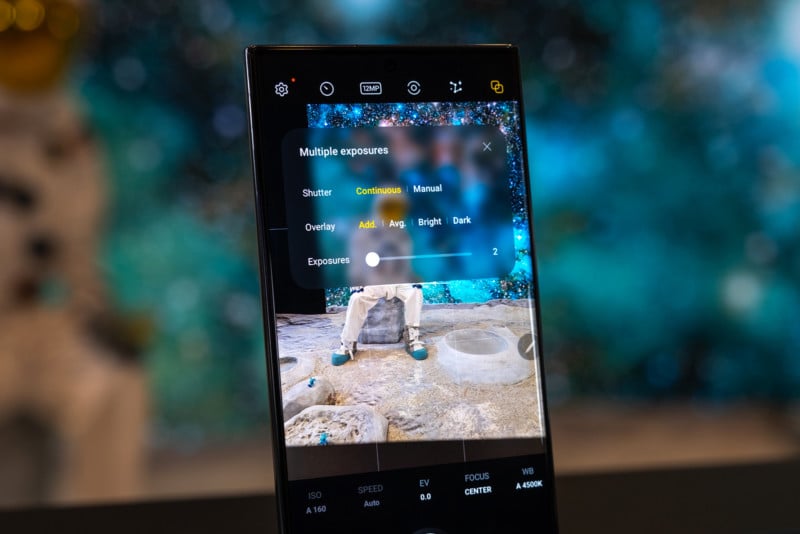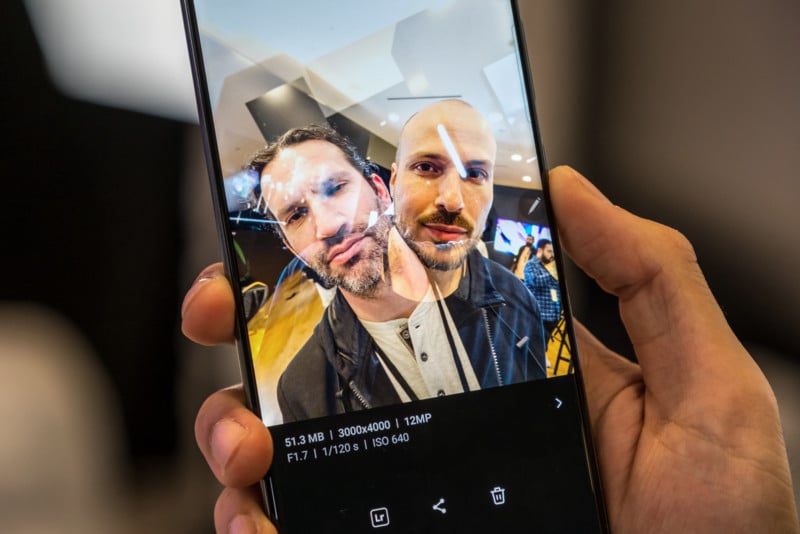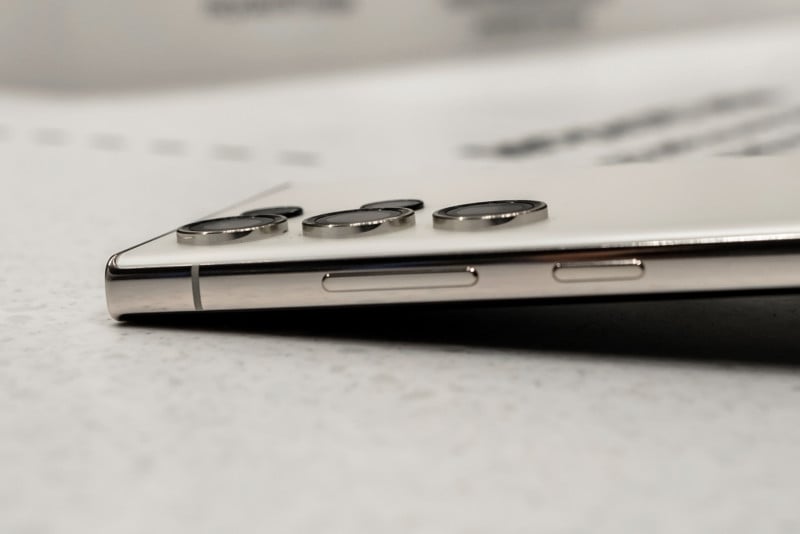Samsung Unveils New Galaxy S23 Devices, Flagship Packs 200MP Sensor
![]()
Samsung today unveiled its latest trio of flagship smartphones at its annual Unpacked event in San Francisco, led by the Galaxy S23 Ultra, and flanked by the Galaxy S23+ and Galaxy S23.
As some may expect, these are mostly iterative updates to the previous models, though some key differences stand out. Samsung is also taking aim at the best in mobile photography by equipping a new image sensor and even throwing a bone or two to more prosumer shooters. We’ll wait to judge the results once we review them at PetaPixel.

A New Ultra Image Sensor
Samsung announced its latest 200-megapixel ISOCELL HP2 image sensor prior to this launch, which fits in with one of the themes behind the Galaxy S23 Ultra: night and low-light photography. It may feel like a case of déjà vu for Samsung, given it’s referred to its ‘Nightography” in multiple launches, but will be interesting to see how this phone shoots under those conditions.
![]()
The HP2 sensor uses Tetra2pixel — or 4×4 — pixel binning to change how it shoots at different resolutions. By default, 4×4 binning in the main photo mode will shoot at 12.5-megapixels with larger 2.4μm, though it can also group pixels in 2×2 binning to shoot at 50 megapixels at 1.2μm. For the full 200 megapixels, it drops to 0.6μm. When you shoot 8K video, the HP2 will switch to 50 megapixels at 1.2μm to negate it from cropping the frame too much.
While I had time with the devices, I had no way of telling whether the new sensor in the S23 Ultra leads to better or different results in various conditions, including low light.
More to Come With Expert RAW
Samsung also embedded Expert RAW into the camera app rather than hiding it in the Galaxy Store like it did before. It also now lets you shoot at 50 megapixels, a big improvement over the 12-megapixel limit from the Galaxy S22 Ultra.
We confirmed that there is no way for the S23 Ultra to shoot RAW at 200 megapixels. While others might claim otherwise, the company says that it’s not possible, at least right now.
Samsung is playing up the newest modes available, and one that could trigger some creativity — as well as terrible failures — is Multiple Exposure. It lets you capture multiple images and layer them on top of each other. It can do this with up to nine photos, in either a continuous or manual shooting setting. Basically, this means you can either capture a subject in a continuous motion or manually shoot different scenes and layer elements from them on top of each other in different opacities.

This mode is actually baked into Expert RAW and will only work when shooting at 12 megapixels. It’s also unclear exactly what sequence works best. When I briefly tested it by shooting a bright subject first, and a dark one second, the results were awful.

When it was done in reverse, it was much better. There is an option to choose different compositions, but it’s unclear how this truly works in practice until proper testing. The mode will let you shoot using all the rear lenses, so it is possible to layer perspectives, too.
Astrophotography is also baked into Expert RAW, a mode Samsung believes will compete with the likes of Google’s own Astrophotography mode. One difference here is the mode is entirely elective in Samsung’s phones, meaning you can use it anytime, except it shoots at a minimum of a four-minute exposure, so is useless unless it’s dark enough outside. It wasn’t possible to even see this in action, but it, too, also only works in 12-megapixels.
![]()
The wide lens (23mm equivalent) on the Galaxy S23 Ultra dominates the entire lineup here, but there is the 12-megapixel ultra-wide (13mm equivalent), 10-megapixel telephoto (70mm equivalent) and 10-megapixel periscope telephoto (230mm equivalent ) to go with it. Samsung claims night and low-light shots will be better on all of them, thanks to software improvements, but that remains to be seen against stiff competition from other vendors.
![]()
The other two phones don’t change much on the hardware side, with the same 6.6-inch Dynamic AMOLED 2X for the S23+, and the same 6.1-inch Dynamic AMOLED 2X for the S23. From the 50-megapixel wide lens (23mm equivalent), to the 12-megapixel ultra-wide (13mm equivalent) and 10-megapixel telephoto (70mm equivalent), nothing has changed from their predecessors — at least on paper.
The Rest of the Story
As before, the Galaxy S23 Ultra will be the only one in the lineup that not only comes with the S Pen, but also be compatible with it. The pen retains its existing features, including using it as a remote shutter for photos. Samsung hasn’t extended compatibility to the others, so the Galaxy S23+ and Galaxy S23 won’t work with it at all. PetaPixel has confirmed that the S Pen doesn’t do anything different as far as the camera is concerned.
![]()
Many of the other specs stick to familiar ground, with the S23 Ultra keeping the same 6.8-inch Dynamic AMOLED 2X display (3200 x 1440) with 120Hz refresh rate. One change I liked seeing was the curved edges are almost non-existent, giving the phone an even slighter curve than before. The other two models are as flat as they’ve been for years.

No surprise all three phones will run on the Snapdragon 8 Gen 2 processor, along with enhanced graphics power and a cooling system to push the devices as bona fide mobile gaming devices. This may actually play a role when it comes to editing photos and video if the components inside can slash rendering times. Samsung isn’t quantifying that yet, but it’s certainly something I’ll be testing for.
Little has changed as to the common specs, where it’s either 8GB or 12GB of RAM, plus 128GB, 256GB, 512GB, and 1TB of storage. The battery for the S23 Ultra is still 5,000mAh, while each of the other two phones get slight upgrades to 4,700mAh (S23+) and 3,900mAh (S23).
Pricing and Availability
Samsung will launch all three phones in February 2023 with various memory and storage options to choose from, though colors will be uniform across all three devices. The Galaxy S23 Ultra, Galaxy S23+, and Galaxy S23 will come in phantom black, cream, green, and lavender.
The Galaxy S23 starts at $799 and the S23+ starts at $999. The S23 Ultra starts at $1,199.
Image credits: Header photo via Samsung, all others by Ted Kritsonis for PetaPixel.